Warning: pic heavy, as usual. 
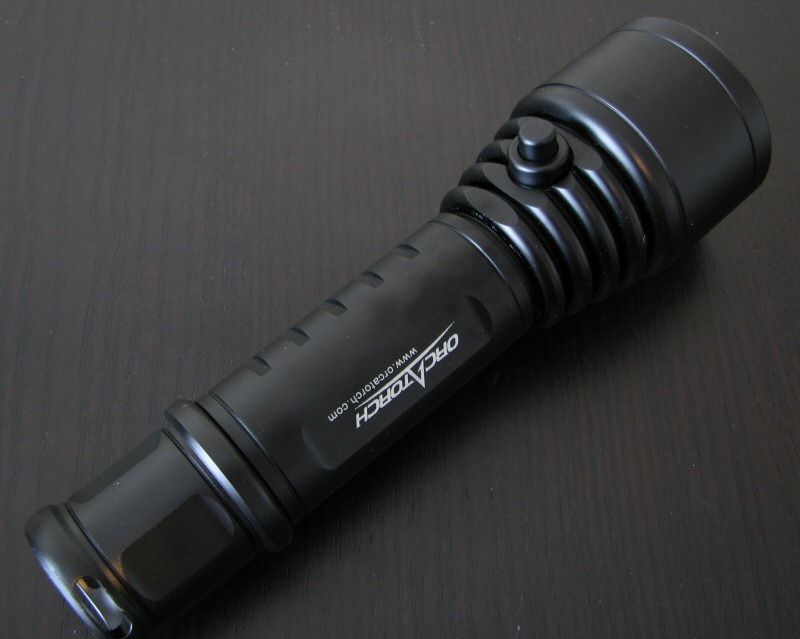
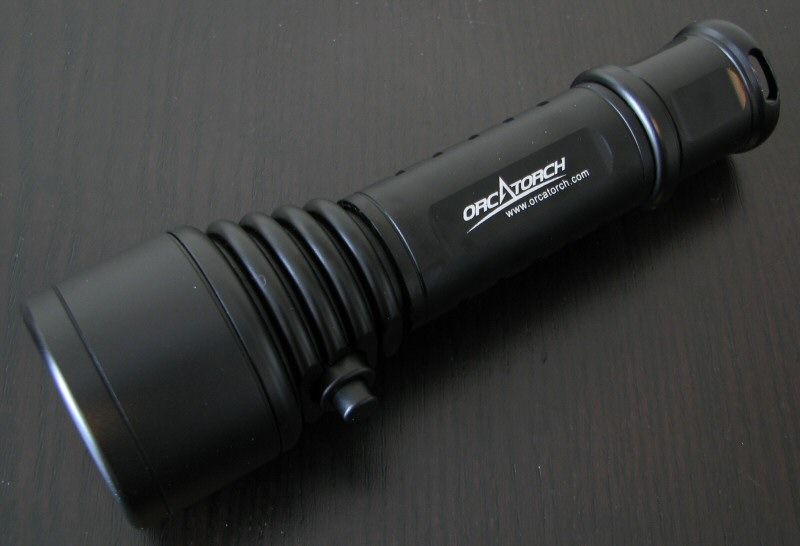
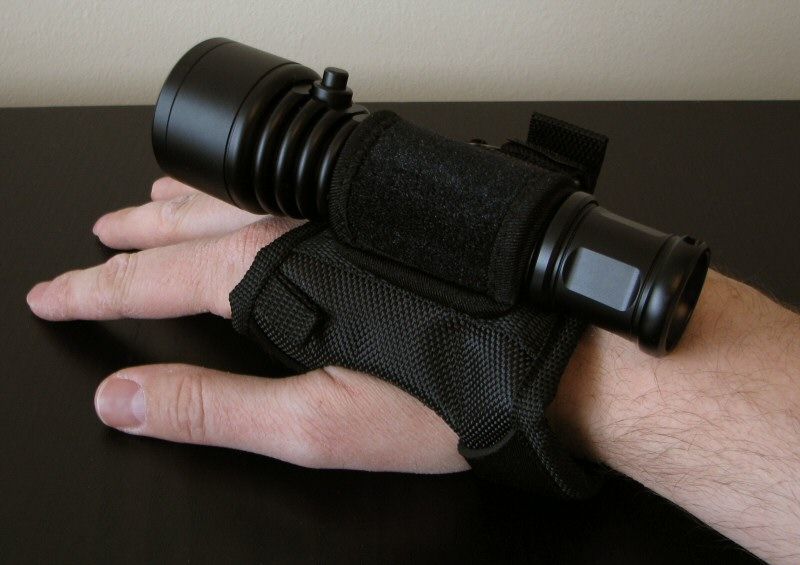
Orcatorch is a new flashlight manufacturer. As you might expect with that name, they specialize in underwater lighting.
They have sent me their first model for testing – the D500 diving light (XM-L2, 1x18650). Let's see how it compares ….
Manufacturer Reported Specifications:
(note: as always, these are simply what the manufacturer provides – scroll down to see my actual testing results).
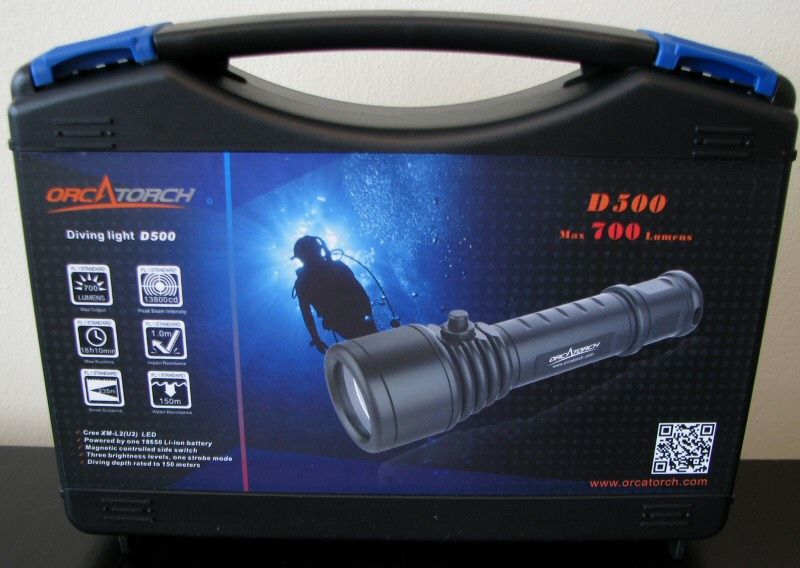
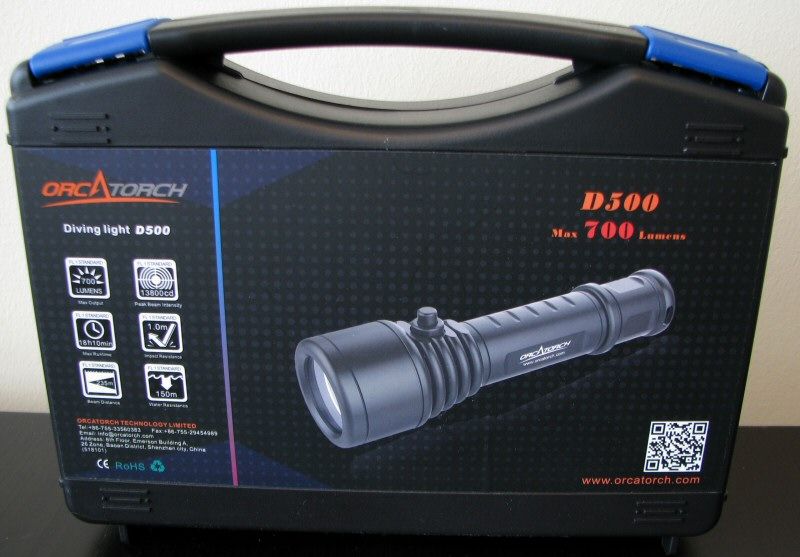
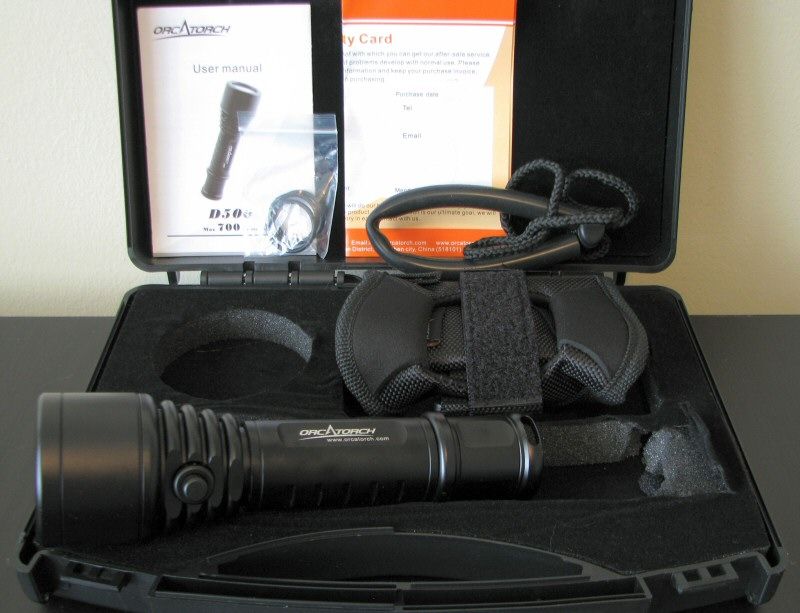
Packaging is a presentation style clam-shell plastic display case. Inside, included with the light are spare O-rings, driving wrist lanyard, diving wrist holster with Velcro flaps, warranty card, and manual.
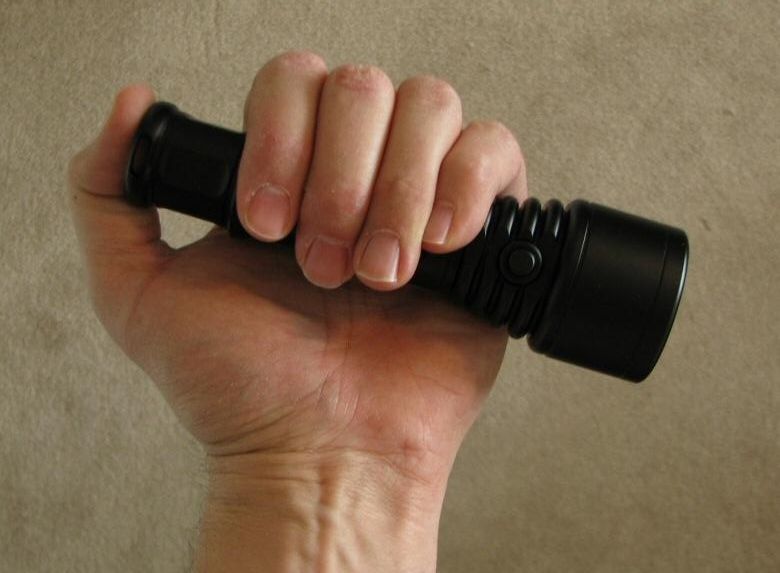
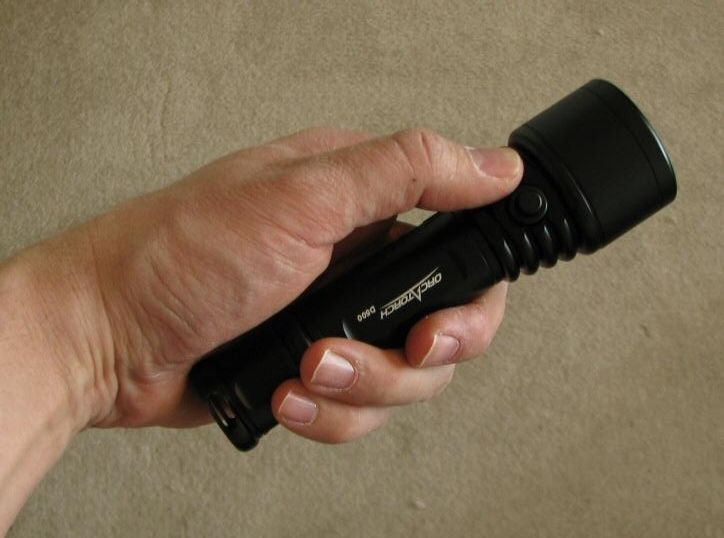
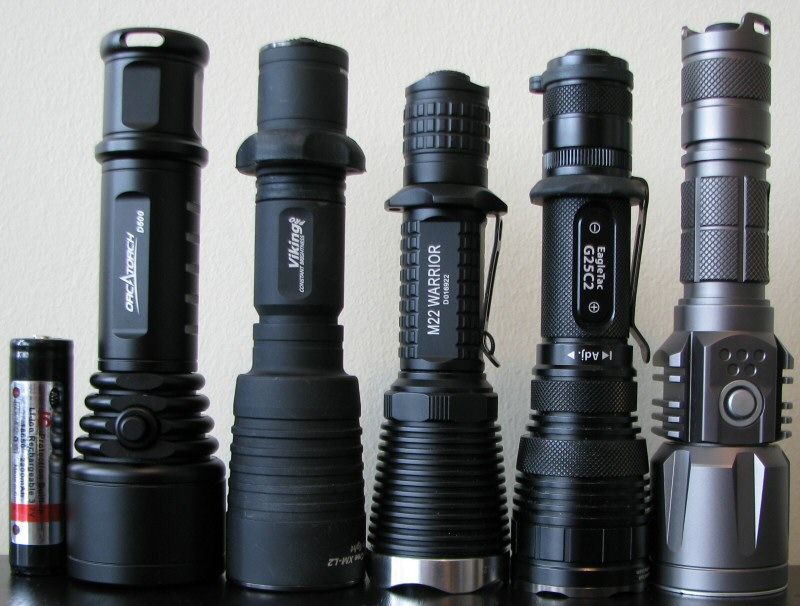
From left to right: AW Protected 18650 2200mAh; Orcatorch D500; Armytek Viking Pro; Olight M22; Eagletac G25C2 Mark II; Nitecore P25.
All dimensions directly measured, and given with no batteries installed:
Orcatorch D500: Weight: 217.8g, Length: 152.7mm, Width (bezel): 44.9mm
Eagletac G25C2-II (stock): Weight 141.0g, Length: 150.6mm, Width: 39.6mm
Eagletac TX25C2: Weight 93.6g, Length: 120.4mm, Width (bezel): 31.6mm
Fenix PD35: Weight: 82.7g, Length: 138.1mm, Width (bezel): 25.4mm
Foursevens MMX Burst: Weight 145.8g, Length: 153.3mm, Width (bezel): 38.7mm
Light & Motion GoBe+ 500 Search: Weight (with built-in battery): 189.2g, Length: 132.4mm, Width (bezel screw threads): 47.7mm
Nitecore P12: Weight: 89.7g, Length: 139.4mm, Width (bezel): 25.4mm
Nitecore P25: Weight: 171.3g, Length: 160mm, Width (bezel): 40.0m
Olight M22: Weight: 148.4g, Length: 144.8mm, Width: 41.2mm (bezel)
Zebralight SC600 II: Weight 79.3g, Length: 101.8mm, Width (bezel) 29.7mm
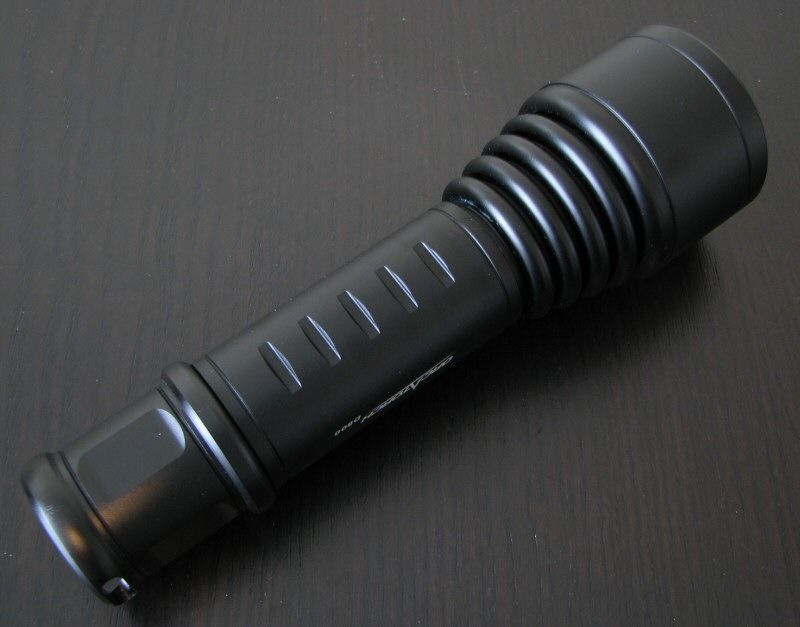
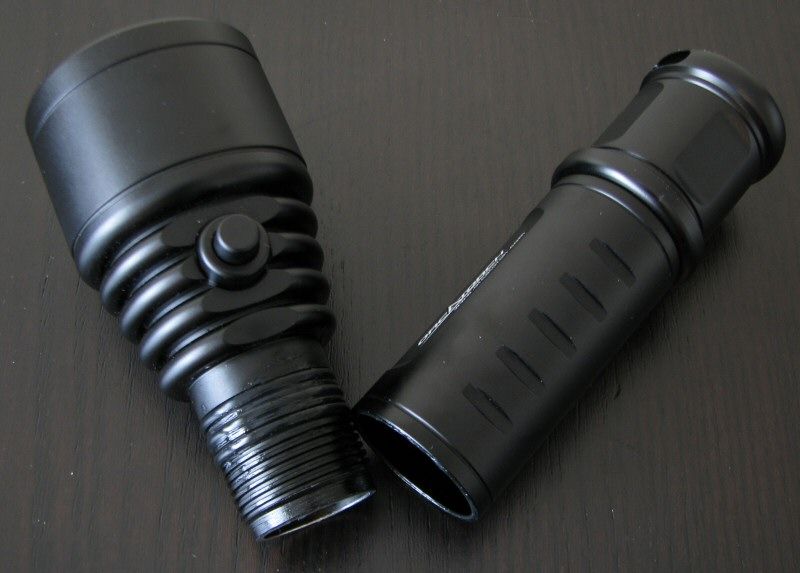
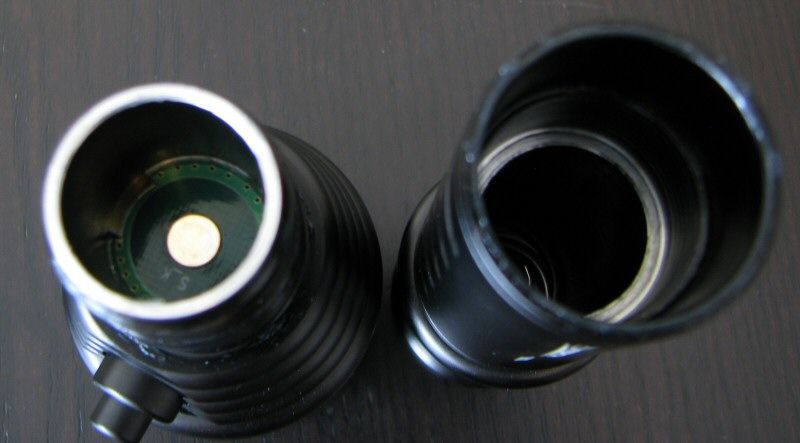
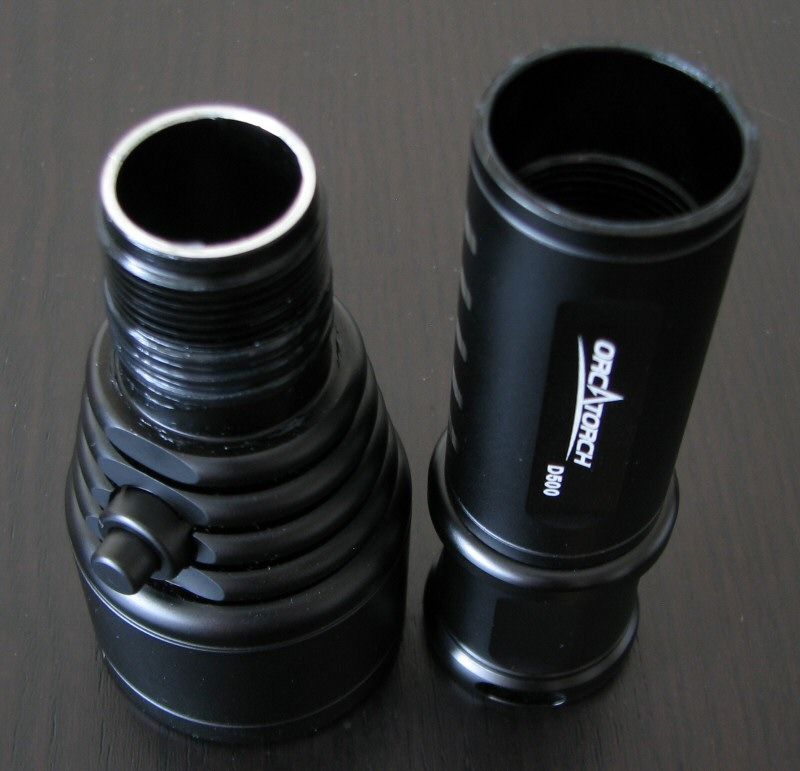
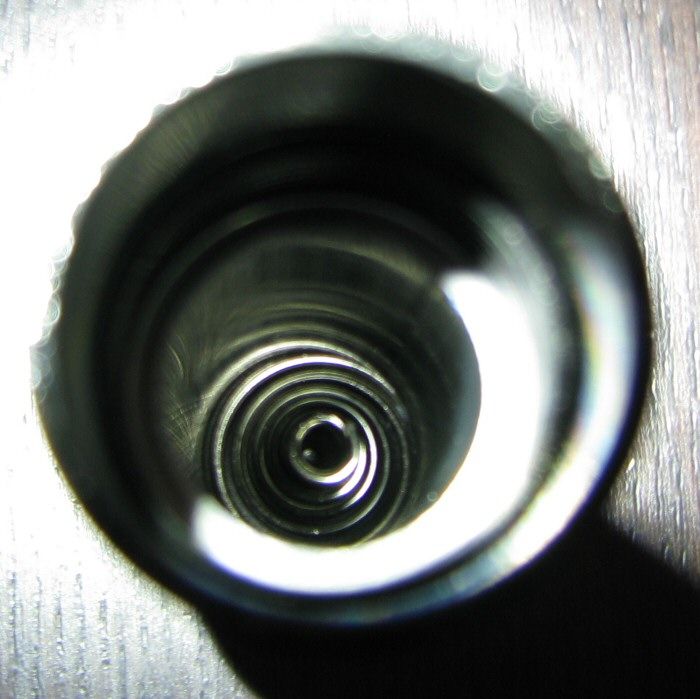
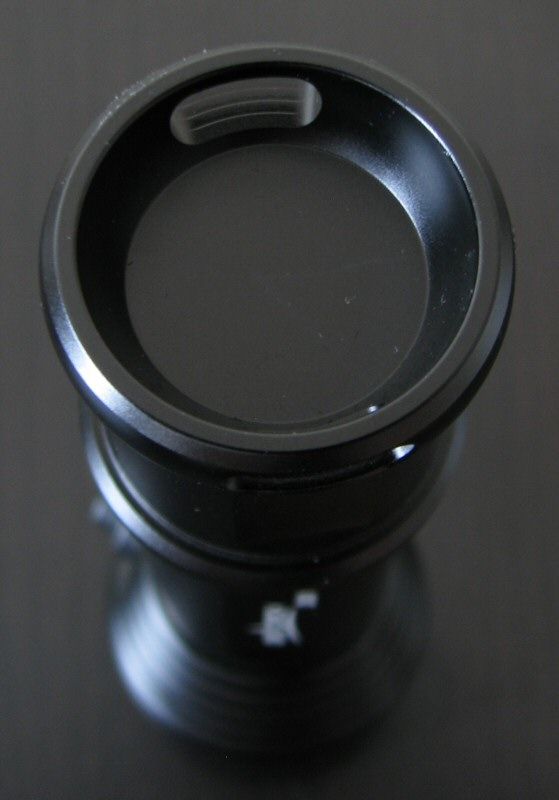
The D500 is a stocky light, as is common on diving lights (i.e., thick-walled to withstand higher pressures). Anodizing is a matte black finish, hard anodized, with no chips or damage on my sample. Body labels are bright white against the black background. There is no knurling to speak of on the body, but there are a number of ridges and concentric rings (although these are quite smooth). I would consider the light to be relative smooth overall – which is part of the reason why it comes with the lanyard and wrist holster.
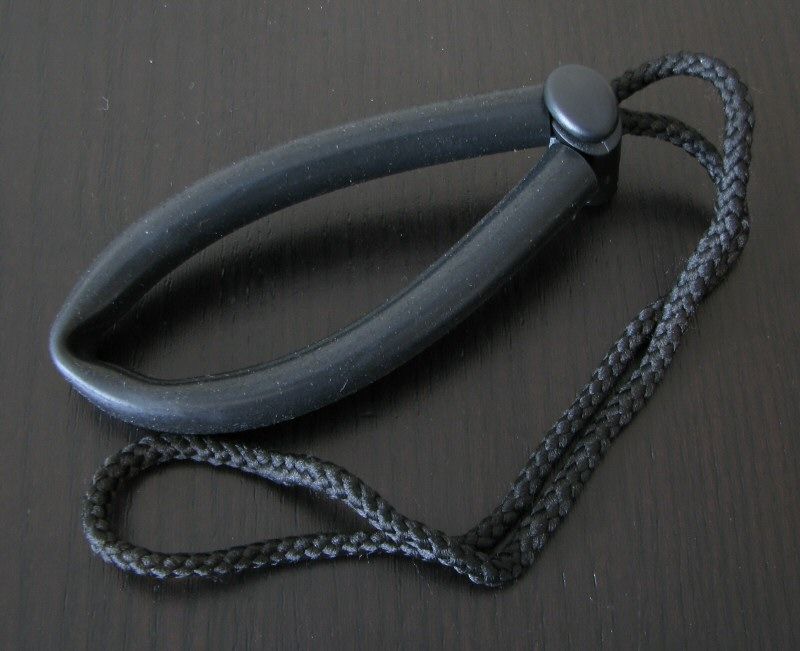
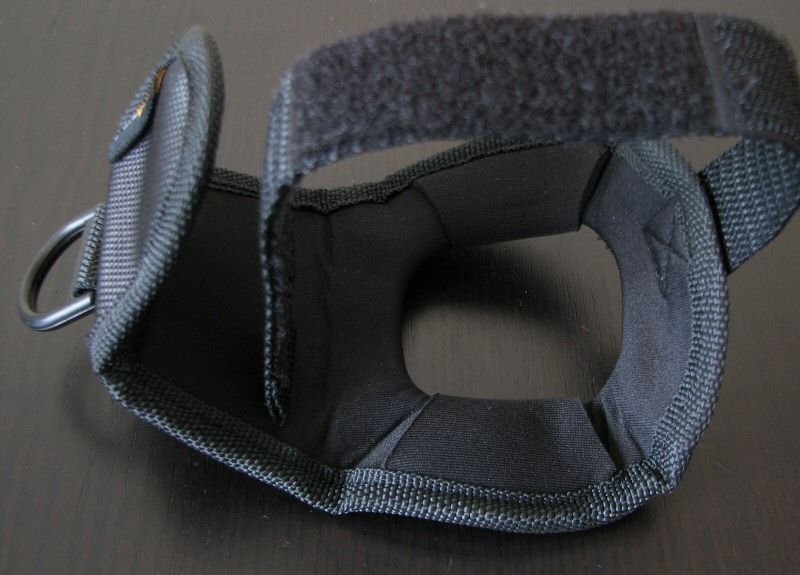
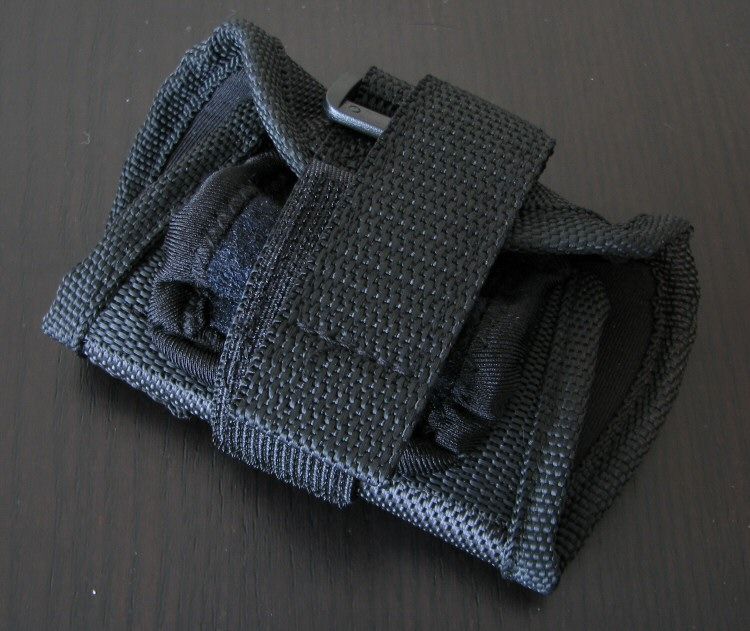
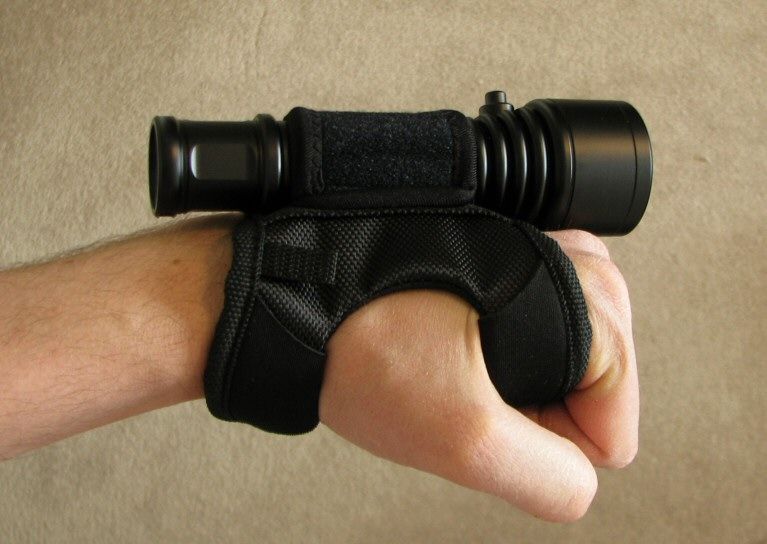
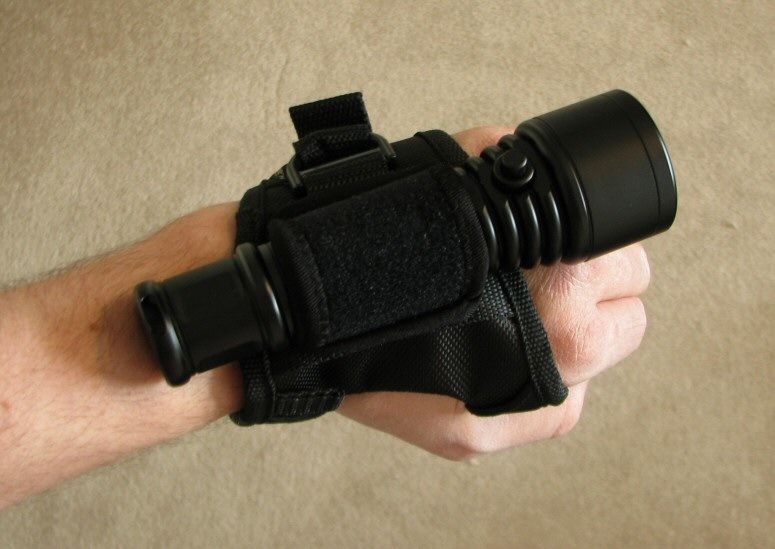
I am not a scuba diver, but it seems to me that this holster would work quite well for that purpose. The elastic material holds the light quite securely.
A unique feature to the D500 is the magnetically-isolated switch. Normally, the switch housing is loctited on shipping samples, but Orcatorch sent me one that wasn't so that I could show you what it looks like.
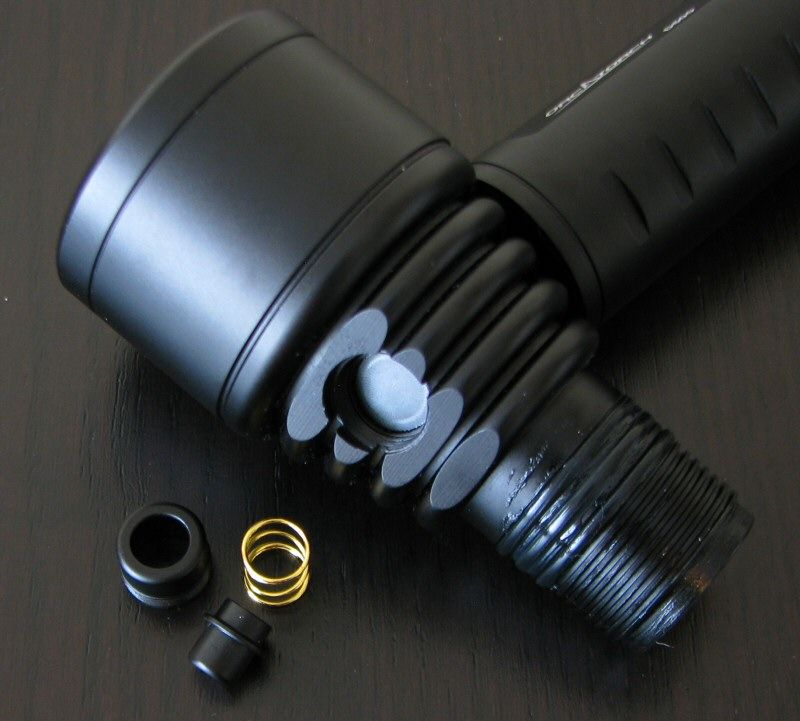
As you can probably tell from the above, the circuit internals are fully isolated and protected – the light is waterproof even without the switch in place. The switch cover itself is basically just a piece a plastic with a small rare earth magnet at the inside end. When you press the switch down all the way, the magnet activates the internal switching mechanism. The gold-plated spring simply provides resistance, and pushes the switch cover back out. The whole assembly screws into the light (and would normally be sealed with Loctite).
This is a clever design for a diving light. Note that it makes for an unusual switch feel – it's basically like a little plunger, with no click or other evidence of physical contact. All you are doing is getting the magnet close enough to register with the internal control mechanism. See my User Interface section for more info.
Screw threads are square cut, and there are a greater number than usual. Threads are anodized, allowing for a physical lock out. The head seats quite deeply on the light, and has two o-rings for waterproofness. There was a generous amount of lube on the threads and o-rings on my sample.
There is a small (slightly raised) contact on the board in the head, so some flat-top cells can be used. All of my cells worked, except the recessed flat-top AW cells. All button top cells work fine, of course. The body tube is wide enough to accommodate all size 18650 cells. There is a spring at the base of the body tube.
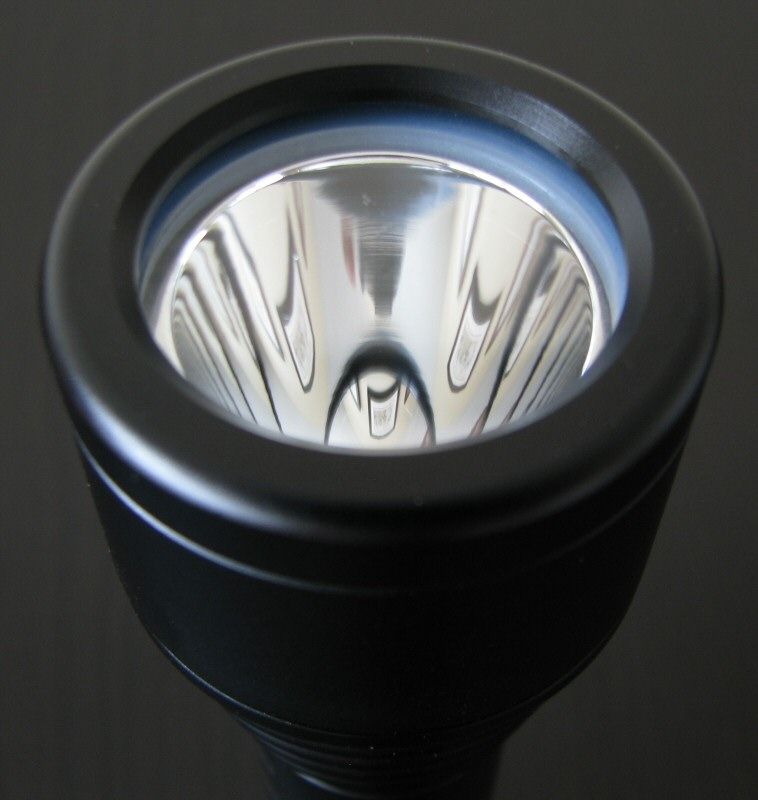
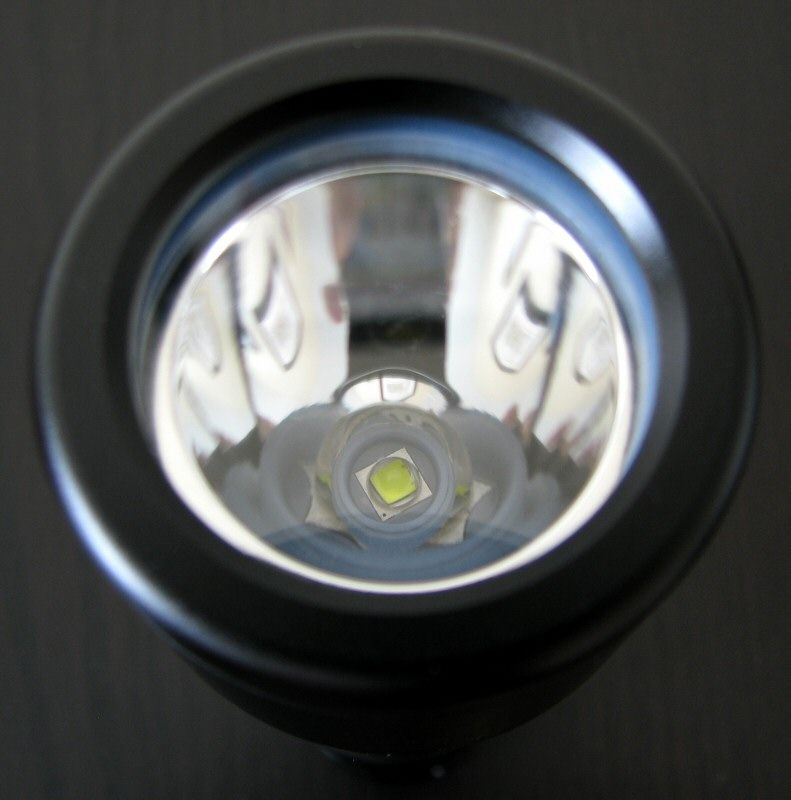
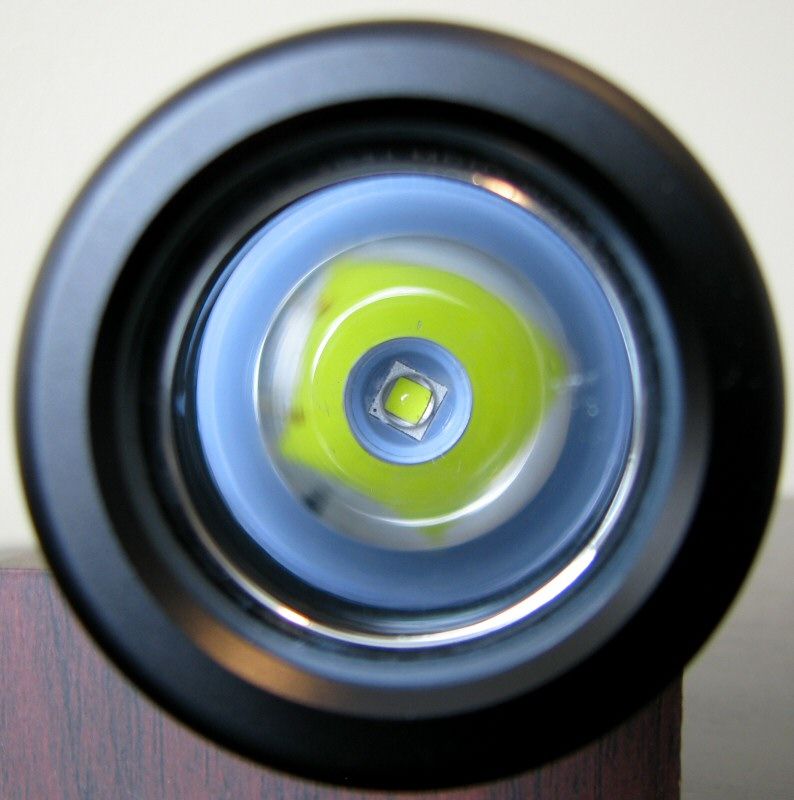
The head is substantial on D500, with a remarkably thick lens (4mm). This is again to provide depth resistance. Note that due to its thickness, I find it slightly opaque compared to most lights (i.e., slightly less transmittance than typical). Given the reflector size, I would expect the light to be relatively more focused for center-beam throw. Scroll down for beamshots.
As I am not a scuba diver, I have no real way to test out the light's performance at depth. I can tell you it works just fine for operation and mode switching under water in my bathtub – but that probably doesn't help you much.
So how best to simulate the increased pressure of water depth? Well, the best I could think of was to try freezing the light in water. I don't imagine this hugely increases the pressure on the light (since all my containers allow room for the ice to expand) – but it certainly is another level of stringency.
Freeze test #1:
I started by placing the light (on Lo) in a bucket on top of ice:
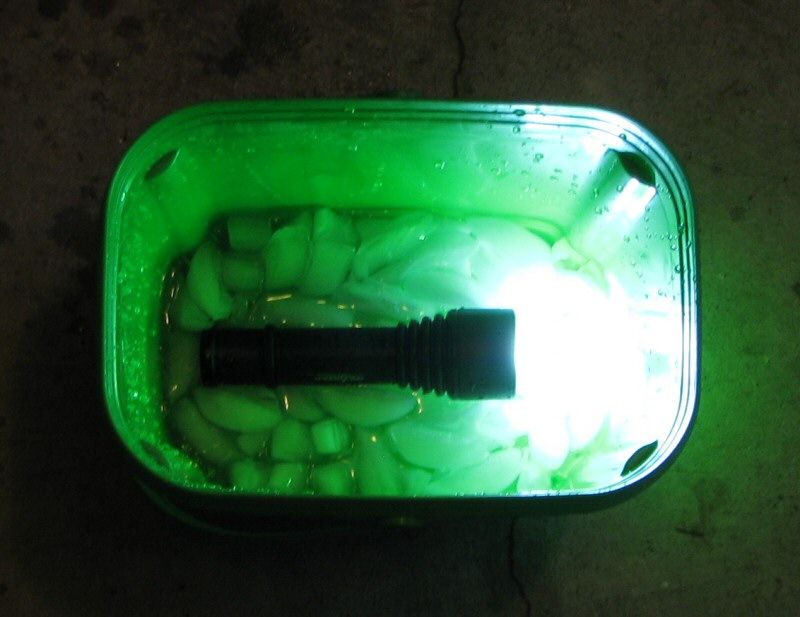
I then half-filled the bucket with water and left outside one night at around -10 C for 6 hours:
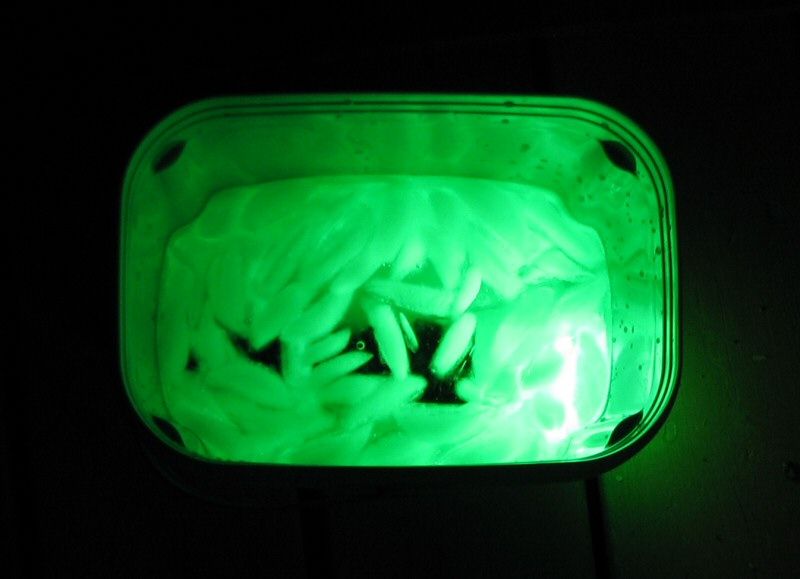
Unfortunately, the ice wasn't fully formed around the light, so I figured I need to change things around a bit. Note that the light survived this rather mild test just fine, with no signs of any water entry.
Freeze test #2:
For this test, I put the light in a smaller container of ice water:
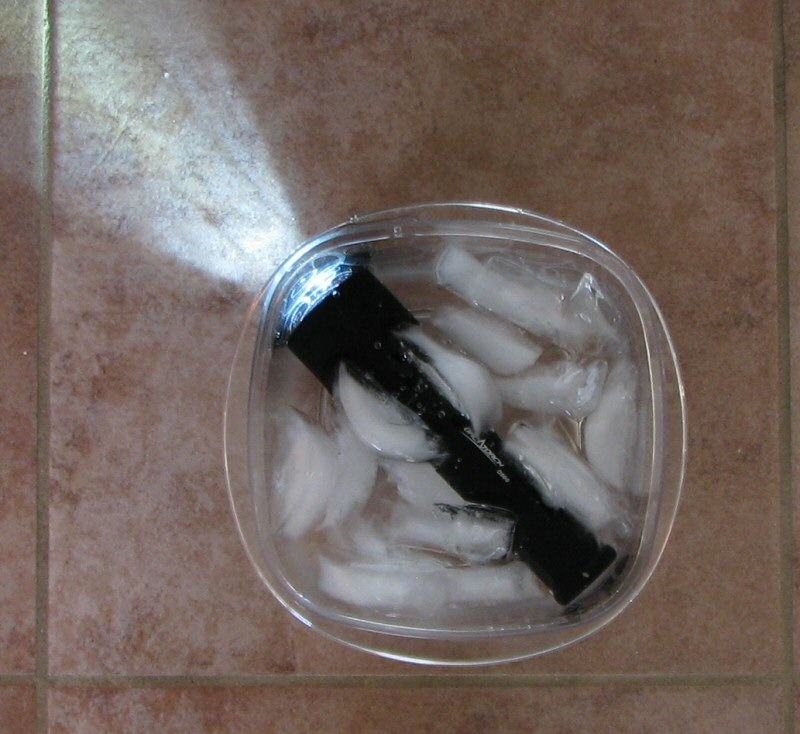
And stuck in my freezer for 12 hours:
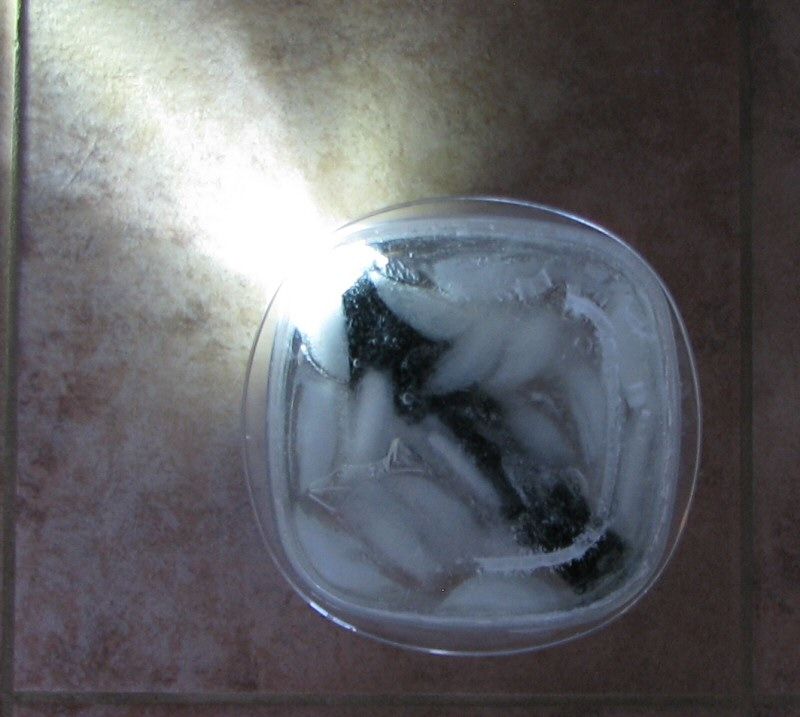
Now the light came out pretty well frozen in a block. I then placed everything in a sink and started melting away at the ice with lukewarm water:
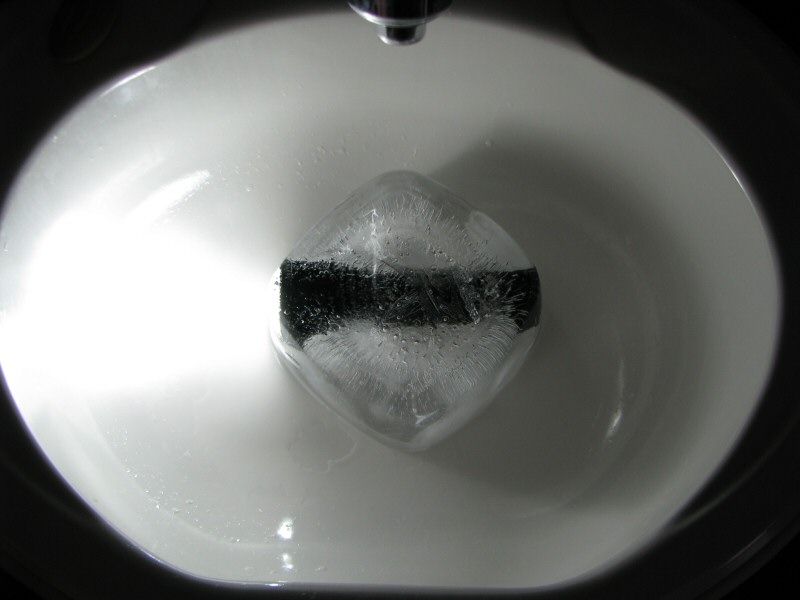
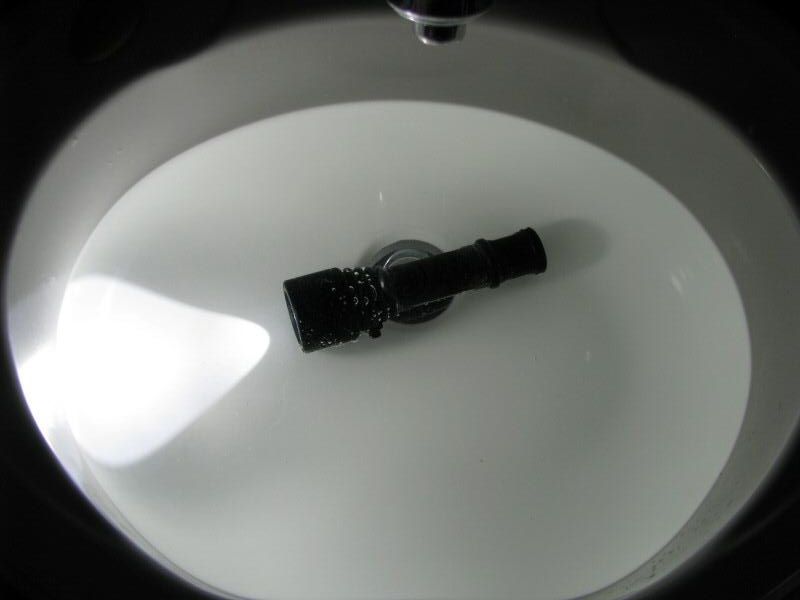
I then drained the sink:
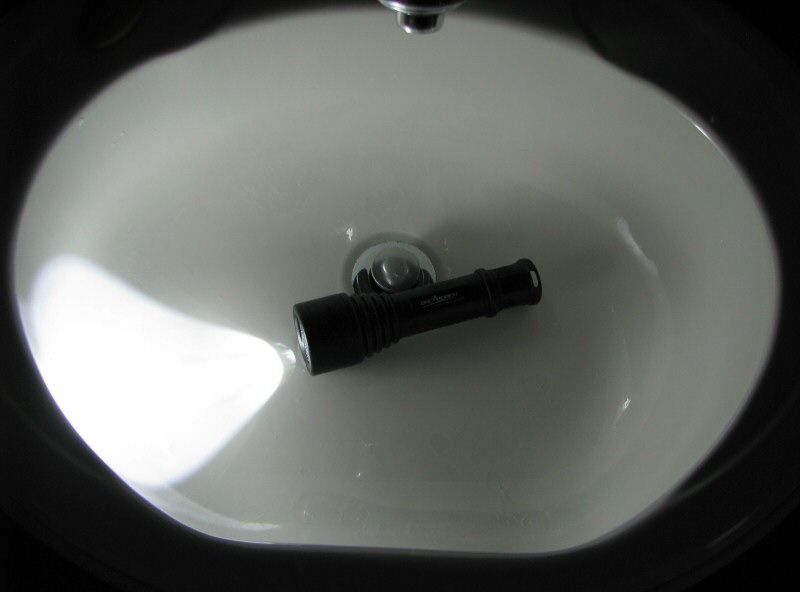
And examined the light closely. There were absolutely no signs of water entry at any surface. I opened the light, and saw all water was stopped by the first o-ring – the inside was completely dry. :thumbsup:
Based on these rather simple tests, I suspect the light will function fine for typical diving purposes. :wave:
User Interface
When first connecting the light, it comes on in Lo.
Press and release the switch to advance the light to off.
Mode sequence is Hi > Med > Lo > Off, in repeating sequence. Or, starting from when you first connect the head: Lo > Off > Hi > Med, etc.
Unfortunately, you need to cycle between all the modes to turn off. Alternatively, you would twist the head slightly to physically lock out the light (with Lo upon re-tightening).
At any time, press and hold the switch for ~3 secs to activate the Strobe mode. This works from off or any of the constant output modes. A single press-release returns you to the last mode you were in.
Note that the magnetically-isolated switch does not "click" in any way, but functions as a reverse-clicky style switch for constant-output modes (i.e., the mode only changes once you release). It is just the strobe mode where it responds after a period of sustained pressure.
Video:
For information on the light, including the build and user interface, please see my video overview:
As with all my videos, I recommend you have annotations turned on. I commonly update the commentary with additional information or clarifications before publicly releasing the video.
PWM/Strobe
The D500 uses pulse-width modulation (PWM) for its Lo and Med modes, but at a fairly high frequency.
Lo PWM:
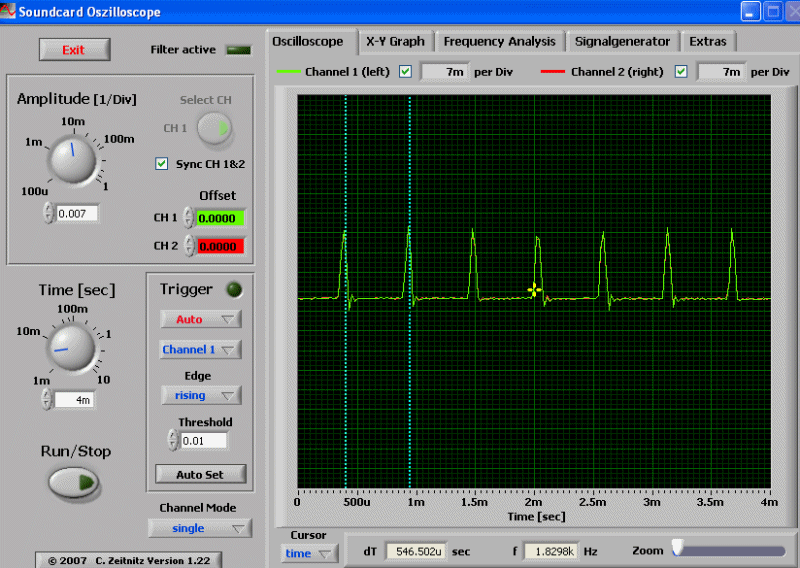
Med PWM:
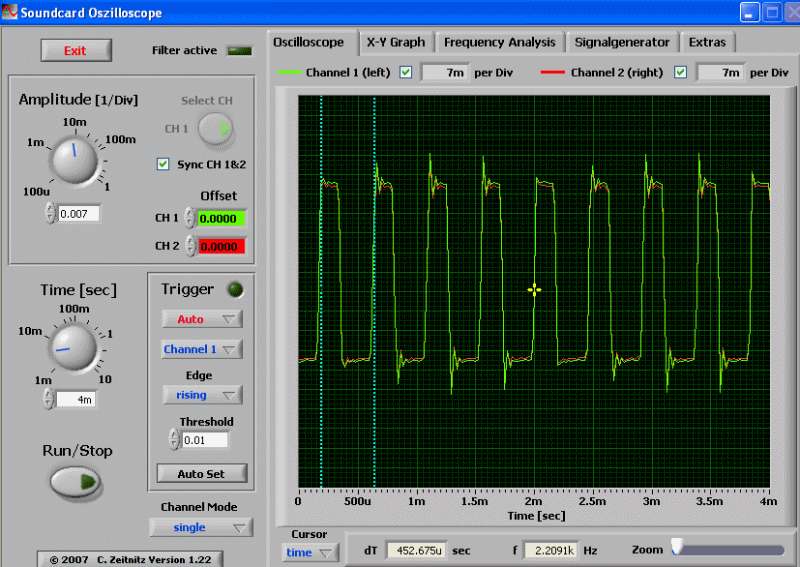
As you can see, PWM of 1.8-2.2 kHz is used on the Lo/Med modes. This frequency is high enough that you would be very hard-pressed to notice the flicker in real life. I am personally very sensitive to PWM flicker effects, and find these frequencies acceptable (although I can still detect them visually).
Lo Noise:
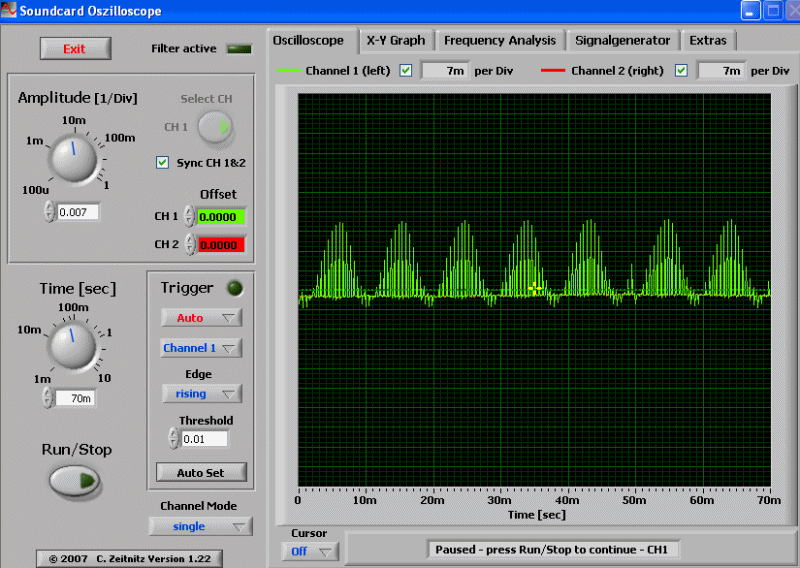
There was some additional noise present on the Lo mode, but this doesn't seem to introduce any additional visual effect.
Strobe
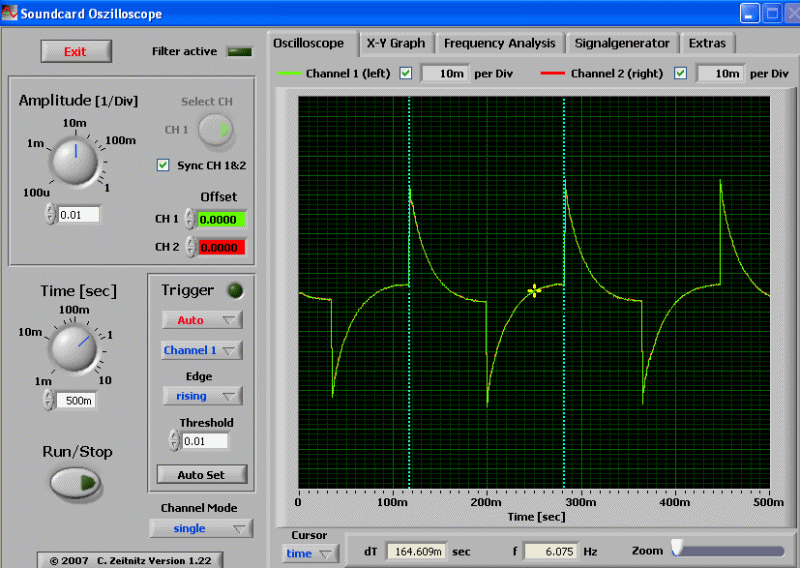
The strobe mode is of medium speed - 6 Hz frequency.
Standby Drain:
Due to the electronic nature of the switch in the head, there is a necessary standby drain when connected to the battery. Unfortunately, my DMM is on the fritz at the moment, and I am waiting on a replacement to do the standby drain draws. I will update the review when I have more details.
Beamshots:
For white-wall beamshots below, all lights are on Max output on an AW protected 18650 battery. Lights are about ~0.75 meter from a white wall (with the camera ~1.25 meters back from the wall). Automatic white balance on the camera, to minimize tint differences.
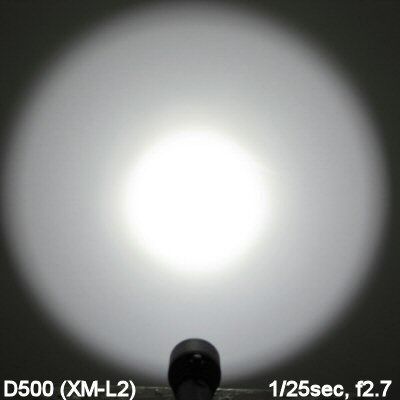
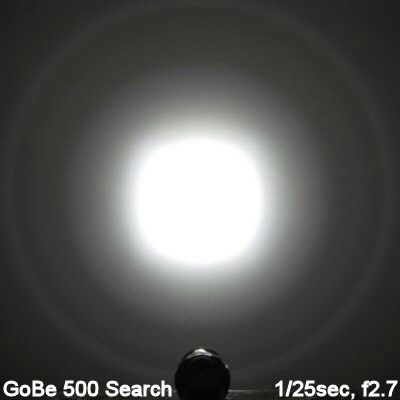
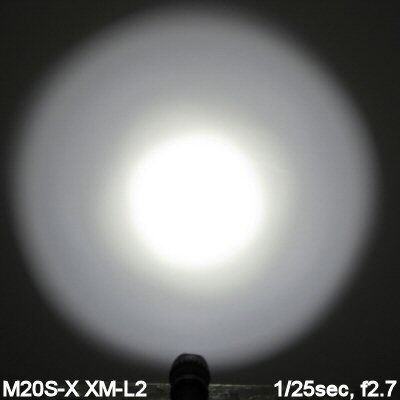
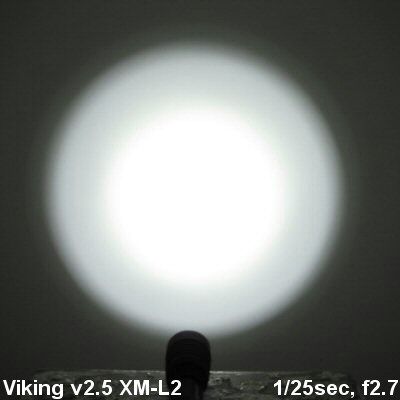
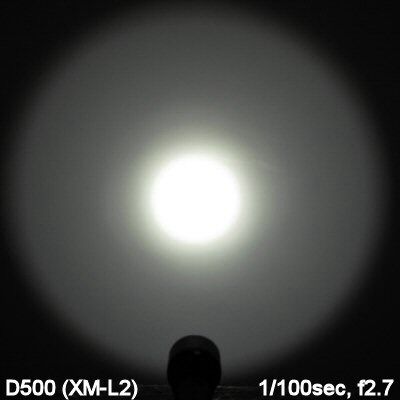
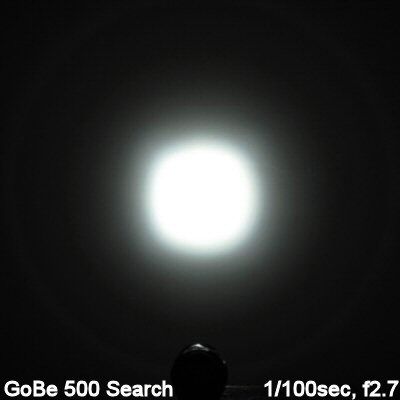
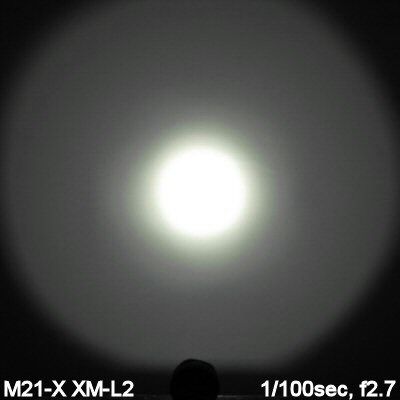
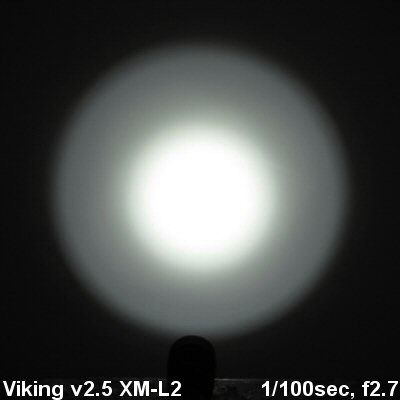
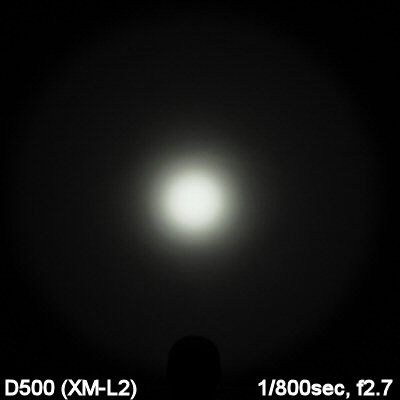
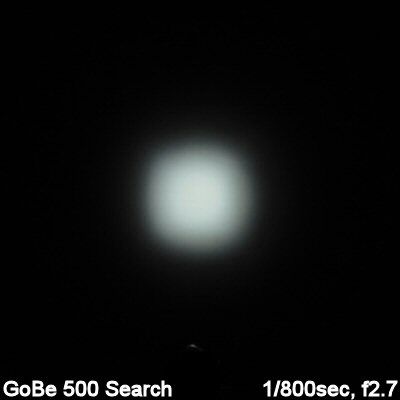
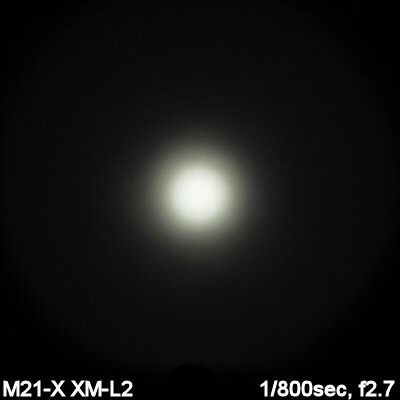
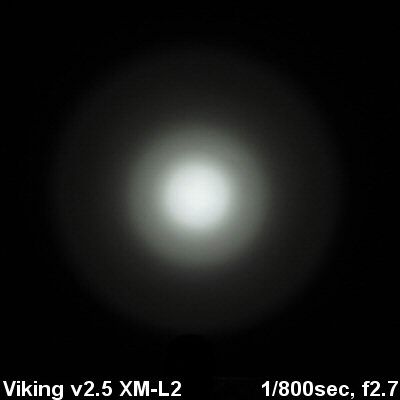
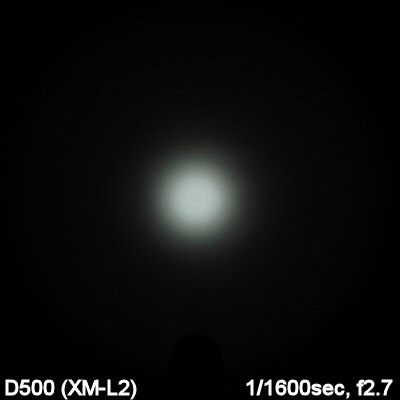
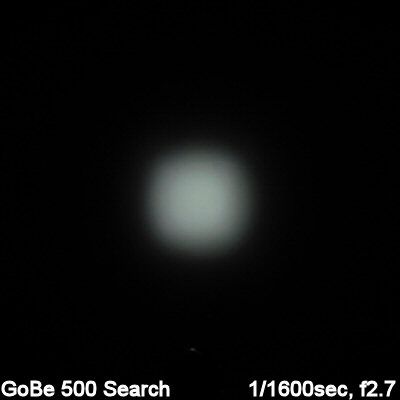
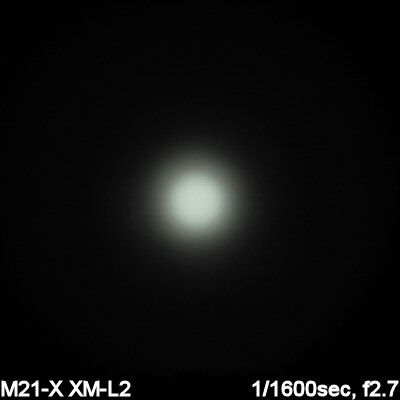
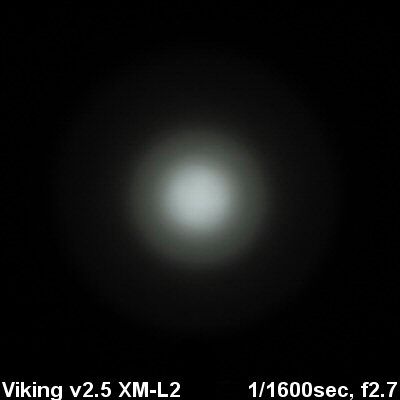
Beam pattern is what you would expect for a light this size – a fairly throwy hotspot, proportionately-speaking. Scroll down for detailed output and throw measures.
Testing Method:
All my output numbers are relative for my home-made light box setup, as described on my flashlightreviews.ca website. You can directly compare all my relative output values from different reviews - i.e. an output value of "10" in one graph is the same as "10" in another. All runtimes are done under a cooling fan, except for any extended run Lo/Min modes (i.e. >12 hours) which are done without cooling.
I have devised a method for converting my lightbox relative output values (ROV) to estimated Lumens. See my How to convert Selfbuilt's Lightbox values to Lumens thread for more info.
Throw/Output Summary Chart:
My summary tables are reported in a manner consistent with the ANSI FL-1 standard for flashlight testing. Please see http://www.flashlightreviews.ca/FL1.htm for a discussion, and a description of all the terms used in these tables. Effective July 2012, I have updated all my Peak Intensity/Beam Distance measures with a NIST-certified Extech EA31 lightmeter (orange highlights).
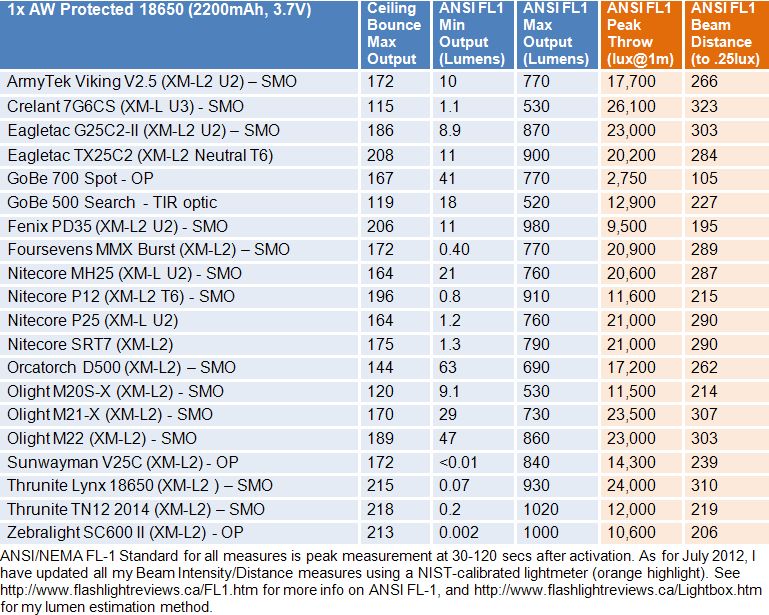
For its size, the D500 is about typical – it has a reasonable amount of overall output and goof throw. In fact, peak intensity was slightly higher in my testing than the published specs. The beamshots earlier in this review will give you a better idea of how it compares in practice,
Let's see how all the levels compare to the official specs in my lightbox:
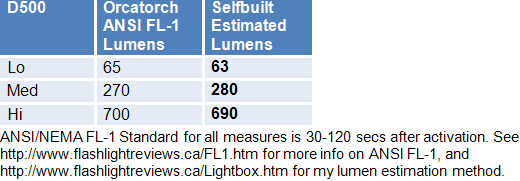
There is excellence concordance between my estimated lumens and Orcatorch's published specs. I expect Orcatorch is using an actual integrating sphere for their measures.
I expect Orcatorch is using an actual integrating sphere for their measures.
Output/Runtime Graphs:
To start, here is a comparison of three levels on the same scale:
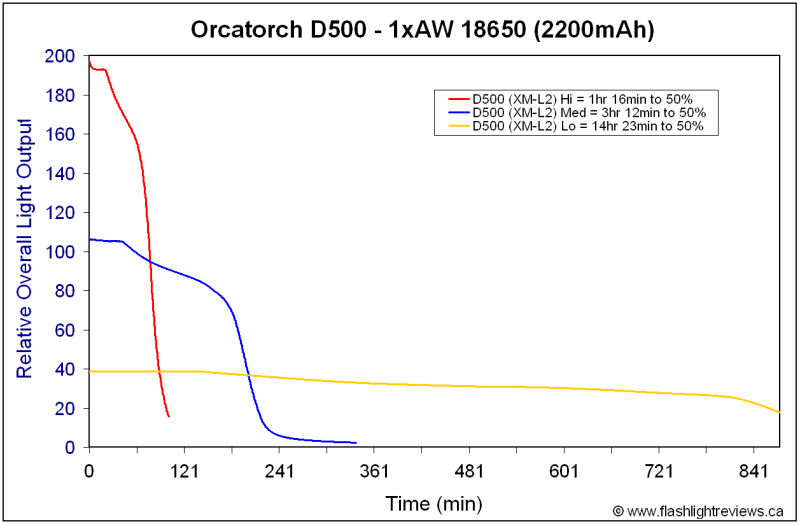
On all modes, the light maintains reasonably flat regulation for a period of time, and drops into a direct-drive-like pattern.
As with the other Orcatorch specs, runtime performance is bang on. Keep in mind that I am using lower capacity 2200mAh cells here, and the ANSI FL-1 standard is time to 10% output).
Let's see how it does against a wider range of lights:
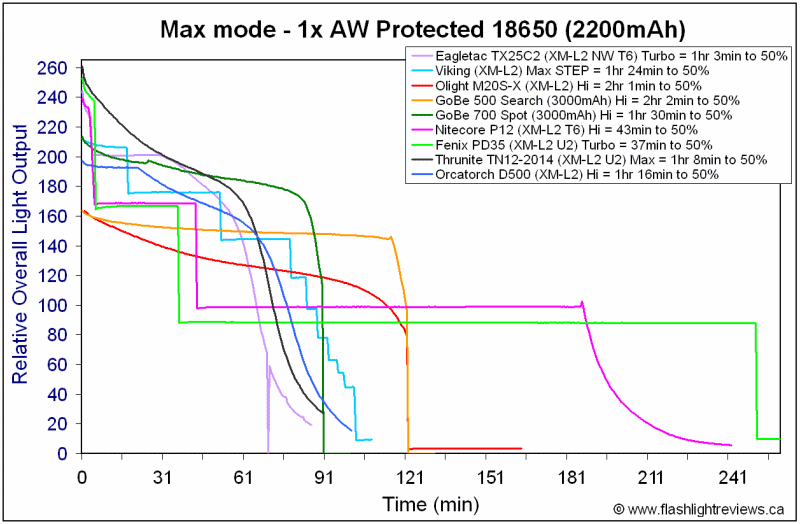
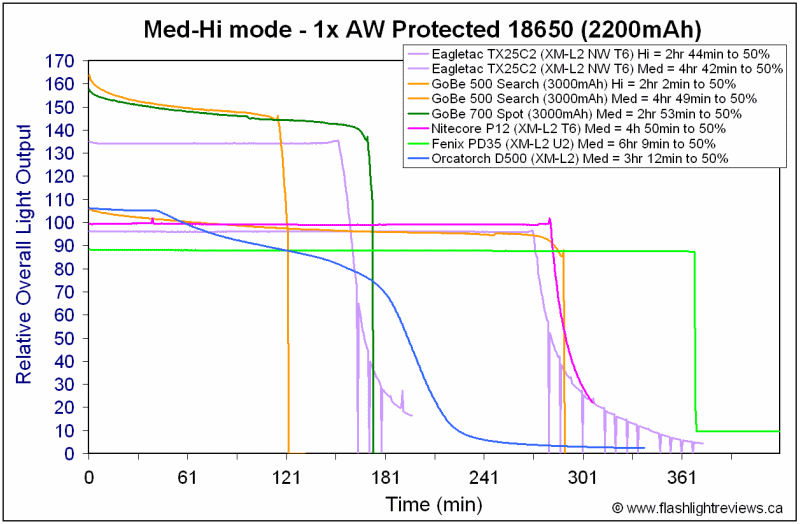
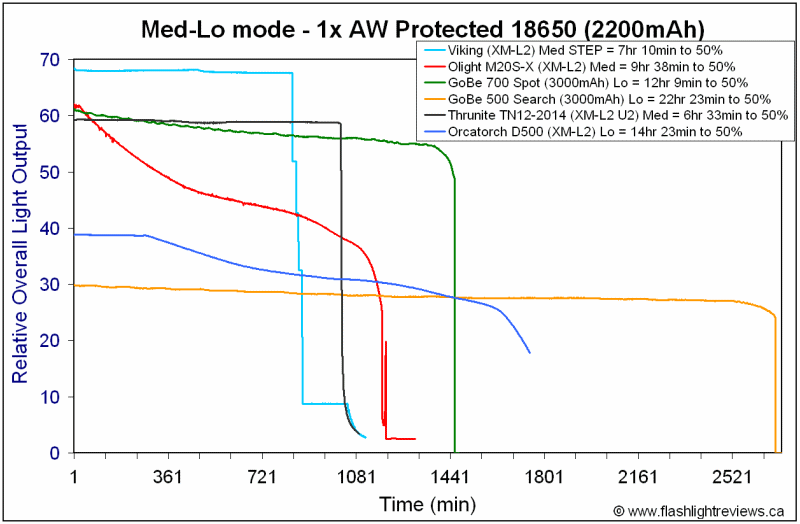
Output/runtime performance on Hi is about typical for the class. The high-frequency PWM on Lo/Med means that the D500 takes a bit of hit compared to the current-controlled competition. But in absolute terms, runtimes are still perfectly acceptable.
Potential Issues
Light uses PWM for its Med/Lo modes, but at a very high frequency (~2 kHz). This is high enough to not be distracting in use. However, there is some loss of efficiency with high-frequency PWM, compared to current-controlled lights.
Light uses an electronic switch, so a standby current is always present. This can easily be broken by a simple head twist (thanks to the anodized threads).
User interface requires you to switch between modes in order to turn off (standby). However, you can again always twist the head to fully turn the light off.
Light is 18650 only (i.e., no primary CR123A supported).
Preliminary Observations
The D500 seems to be a well-made dive light, with appropriate adaptations for the underwater environment. I am not a diver myself, however, so would welcome the input of those around here who are. :wave:
Build-wise, it is a solid light with a thick-walled body. The lens is particular thick as well (4mm), and there are good number and size o-rings throughout (well-lube on the body). There was no sign of water entry on my immersion and freezing tests (even after 12 hours in an ice block in the freezer). :thumbsup:
The most interesting part to me is the switch – the internal mechanism is completely sealed and isolated from the external components. Switching occurs when a small magnet makes proximity contact. This contributes to a unique feel in my testing.
That said, I'm not crazy about the interface (i.e, the need to cycle through modes for off). But that's the cost of the unique design and "hidden" strobe mode – there are only so many possibilities with this sort of isolated switch.
I am not personally a fan of PWM - although Orcatorch has used a relatively high frequency (~2 kHz) in order to keep flicker perception at bay in regular use. Of course, the D500 is not as efficient as current-controlled lights at these output levels, but I find the mix of output levels and runtimes sufficient.
Given its intended use underwater, I think this light has the right mix of throw to spill (i.e., you want a fairly throwy beam for this purpose). While I typically like seeing truly low (and ultra-low) modes on most lights, I also don't think it is required for diving purposes. It is a good balance of levels and performance.
I particularly like the wrist holster – makes a lot of sense for underwater activities. :twothumbs It could even be useful as a headlight replacement on land, as it still leaves your hands relatively free,
End of the day, this seems to my eye to be a well-designed dive light. Since that is not my area of expertise, please feel free to join in on the discussion below! :wave:
-----
D500 provided by Orcatorch for review.



Orcatorch is a new flashlight manufacturer. As you might expect with that name, they specialize in underwater lighting.
They have sent me their first model for testing – the D500 diving light (XM-L2, 1x18650). Let's see how it compares ….
Manufacturer Reported Specifications:
(note: as always, these are simply what the manufacturer provides – scroll down to see my actual testing results).
- LED: Cree XM-L2 U2
- Uses one 18650 Li-ion rechargeable battery
- Diving depth rated to 150 meters, water pressure resistant construction
- Output/Runtime: Hi 700 lumens / 1hr 30min – Med 270lumens / 3hr 40min – Lo 65 lumens / 18hr 10min - Strobe 700 lumens
- Working voltage: 3-4.5V
- Beam Intensity: 13,800cd
- Beam Distance: 235m (on land)
- Magnetic controlled side switch, high waterproofness for easy underwater operation
- Toughened glass lens with high water pressure resistance under deep water (4mm thick lens)
- Alloy aluminum smooth reflector provides long beam distance
- Aircraft-grade high strength aluminum material
- Premium type III military hard-anodized seawater-corrosion-resistance finish
- Reverse polarity protection
- Intelligent memory function, high efficiency constant current circuit
- Impact Resistant: 1m
- Waterproof: underwater 150m
- Dimensions: 152mm (Length) * 28mm (Diameter) * 45mm (Head)
- Weight: 216g weight (without batteries)
- Accessories: O-ring, wrist strap, lanyard (standard wrist strap fastens flashlight to the back of your hand, portable underwater).
- MSRP: $107.95 (contact the manufacturer directly to order)



Packaging is a presentation style clam-shell plastic display case. Inside, included with the light are spare O-rings, driving wrist lanyard, diving wrist holster with Velcro flaps, warranty card, and manual.



From left to right: AW Protected 18650 2200mAh; Orcatorch D500; Armytek Viking Pro; Olight M22; Eagletac G25C2 Mark II; Nitecore P25.
All dimensions directly measured, and given with no batteries installed:
Orcatorch D500: Weight: 217.8g, Length: 152.7mm, Width (bezel): 44.9mm
Eagletac G25C2-II (stock): Weight 141.0g, Length: 150.6mm, Width: 39.6mm
Eagletac TX25C2: Weight 93.6g, Length: 120.4mm, Width (bezel): 31.6mm
Fenix PD35: Weight: 82.7g, Length: 138.1mm, Width (bezel): 25.4mm
Foursevens MMX Burst: Weight 145.8g, Length: 153.3mm, Width (bezel): 38.7mm
Light & Motion GoBe+ 500 Search: Weight (with built-in battery): 189.2g, Length: 132.4mm, Width (bezel screw threads): 47.7mm
Nitecore P12: Weight: 89.7g, Length: 139.4mm, Width (bezel): 25.4mm
Nitecore P25: Weight: 171.3g, Length: 160mm, Width (bezel): 40.0m
Olight M22: Weight: 148.4g, Length: 144.8mm, Width: 41.2mm (bezel)
Zebralight SC600 II: Weight 79.3g, Length: 101.8mm, Width (bezel) 29.7mm






The D500 is a stocky light, as is common on diving lights (i.e., thick-walled to withstand higher pressures). Anodizing is a matte black finish, hard anodized, with no chips or damage on my sample. Body labels are bright white against the black background. There is no knurling to speak of on the body, but there are a number of ridges and concentric rings (although these are quite smooth). I would consider the light to be relative smooth overall – which is part of the reason why it comes with the lanyard and wrist holster.





I am not a scuba diver, but it seems to me that this holster would work quite well for that purpose. The elastic material holds the light quite securely.
A unique feature to the D500 is the magnetically-isolated switch. Normally, the switch housing is loctited on shipping samples, but Orcatorch sent me one that wasn't so that I could show you what it looks like.

As you can probably tell from the above, the circuit internals are fully isolated and protected – the light is waterproof even without the switch in place. The switch cover itself is basically just a piece a plastic with a small rare earth magnet at the inside end. When you press the switch down all the way, the magnet activates the internal switching mechanism. The gold-plated spring simply provides resistance, and pushes the switch cover back out. The whole assembly screws into the light (and would normally be sealed with Loctite).
This is a clever design for a diving light. Note that it makes for an unusual switch feel – it's basically like a little plunger, with no click or other evidence of physical contact. All you are doing is getting the magnet close enough to register with the internal control mechanism. See my User Interface section for more info.
Screw threads are square cut, and there are a greater number than usual. Threads are anodized, allowing for a physical lock out. The head seats quite deeply on the light, and has two o-rings for waterproofness. There was a generous amount of lube on the threads and o-rings on my sample.
There is a small (slightly raised) contact on the board in the head, so some flat-top cells can be used. All of my cells worked, except the recessed flat-top AW cells. All button top cells work fine, of course. The body tube is wide enough to accommodate all size 18650 cells. There is a spring at the base of the body tube.



The head is substantial on D500, with a remarkably thick lens (4mm). This is again to provide depth resistance. Note that due to its thickness, I find it slightly opaque compared to most lights (i.e., slightly less transmittance than typical). Given the reflector size, I would expect the light to be relatively more focused for center-beam throw. Scroll down for beamshots.
As I am not a scuba diver, I have no real way to test out the light's performance at depth. I can tell you it works just fine for operation and mode switching under water in my bathtub – but that probably doesn't help you much.
So how best to simulate the increased pressure of water depth? Well, the best I could think of was to try freezing the light in water. I don't imagine this hugely increases the pressure on the light (since all my containers allow room for the ice to expand) – but it certainly is another level of stringency.
Freeze test #1:
I started by placing the light (on Lo) in a bucket on top of ice:

I then half-filled the bucket with water and left outside one night at around -10 C for 6 hours:

Unfortunately, the ice wasn't fully formed around the light, so I figured I need to change things around a bit. Note that the light survived this rather mild test just fine, with no signs of any water entry.
Freeze test #2:
For this test, I put the light in a smaller container of ice water:

And stuck in my freezer for 12 hours:

Now the light came out pretty well frozen in a block. I then placed everything in a sink and started melting away at the ice with lukewarm water:


I then drained the sink:

And examined the light closely. There were absolutely no signs of water entry at any surface. I opened the light, and saw all water was stopped by the first o-ring – the inside was completely dry. :thumbsup:
Based on these rather simple tests, I suspect the light will function fine for typical diving purposes. :wave:
User Interface
When first connecting the light, it comes on in Lo.
Press and release the switch to advance the light to off.
Mode sequence is Hi > Med > Lo > Off, in repeating sequence. Or, starting from when you first connect the head: Lo > Off > Hi > Med, etc.
Unfortunately, you need to cycle between all the modes to turn off. Alternatively, you would twist the head slightly to physically lock out the light (with Lo upon re-tightening).
At any time, press and hold the switch for ~3 secs to activate the Strobe mode. This works from off or any of the constant output modes. A single press-release returns you to the last mode you were in.
Note that the magnetically-isolated switch does not "click" in any way, but functions as a reverse-clicky style switch for constant-output modes (i.e., the mode only changes once you release). It is just the strobe mode where it responds after a period of sustained pressure.
Video:
For information on the light, including the build and user interface, please see my video overview:
As with all my videos, I recommend you have annotations turned on. I commonly update the commentary with additional information or clarifications before publicly releasing the video.
PWM/Strobe
The D500 uses pulse-width modulation (PWM) for its Lo and Med modes, but at a fairly high frequency.
Lo PWM:

Med PWM:

As you can see, PWM of 1.8-2.2 kHz is used on the Lo/Med modes. This frequency is high enough that you would be very hard-pressed to notice the flicker in real life. I am personally very sensitive to PWM flicker effects, and find these frequencies acceptable (although I can still detect them visually).
Lo Noise:

There was some additional noise present on the Lo mode, but this doesn't seem to introduce any additional visual effect.
Strobe

The strobe mode is of medium speed - 6 Hz frequency.
Standby Drain:
Due to the electronic nature of the switch in the head, there is a necessary standby drain when connected to the battery. Unfortunately, my DMM is on the fritz at the moment, and I am waiting on a replacement to do the standby drain draws. I will update the review when I have more details.
Beamshots:
For white-wall beamshots below, all lights are on Max output on an AW protected 18650 battery. Lights are about ~0.75 meter from a white wall (with the camera ~1.25 meters back from the wall). Automatic white balance on the camera, to minimize tint differences.
















Beam pattern is what you would expect for a light this size – a fairly throwy hotspot, proportionately-speaking. Scroll down for detailed output and throw measures.
Testing Method:
All my output numbers are relative for my home-made light box setup, as described on my flashlightreviews.ca website. You can directly compare all my relative output values from different reviews - i.e. an output value of "10" in one graph is the same as "10" in another. All runtimes are done under a cooling fan, except for any extended run Lo/Min modes (i.e. >12 hours) which are done without cooling.
I have devised a method for converting my lightbox relative output values (ROV) to estimated Lumens. See my How to convert Selfbuilt's Lightbox values to Lumens thread for more info.
Throw/Output Summary Chart:
My summary tables are reported in a manner consistent with the ANSI FL-1 standard for flashlight testing. Please see http://www.flashlightreviews.ca/FL1.htm for a discussion, and a description of all the terms used in these tables. Effective July 2012, I have updated all my Peak Intensity/Beam Distance measures with a NIST-certified Extech EA31 lightmeter (orange highlights).

For its size, the D500 is about typical – it has a reasonable amount of overall output and goof throw. In fact, peak intensity was slightly higher in my testing than the published specs. The beamshots earlier in this review will give you a better idea of how it compares in practice,
Let's see how all the levels compare to the official specs in my lightbox:

There is excellence concordance between my estimated lumens and Orcatorch's published specs.
Output/Runtime Graphs:
To start, here is a comparison of three levels on the same scale:

On all modes, the light maintains reasonably flat regulation for a period of time, and drops into a direct-drive-like pattern.
As with the other Orcatorch specs, runtime performance is bang on. Keep in mind that I am using lower capacity 2200mAh cells here, and the ANSI FL-1 standard is time to 10% output).
Let's see how it does against a wider range of lights:



Output/runtime performance on Hi is about typical for the class. The high-frequency PWM on Lo/Med means that the D500 takes a bit of hit compared to the current-controlled competition. But in absolute terms, runtimes are still perfectly acceptable.
Potential Issues
Light uses PWM for its Med/Lo modes, but at a very high frequency (~2 kHz). This is high enough to not be distracting in use. However, there is some loss of efficiency with high-frequency PWM, compared to current-controlled lights.
Light uses an electronic switch, so a standby current is always present. This can easily be broken by a simple head twist (thanks to the anodized threads).
User interface requires you to switch between modes in order to turn off (standby). However, you can again always twist the head to fully turn the light off.
Light is 18650 only (i.e., no primary CR123A supported).
Preliminary Observations
The D500 seems to be a well-made dive light, with appropriate adaptations for the underwater environment. I am not a diver myself, however, so would welcome the input of those around here who are. :wave:
Build-wise, it is a solid light with a thick-walled body. The lens is particular thick as well (4mm), and there are good number and size o-rings throughout (well-lube on the body). There was no sign of water entry on my immersion and freezing tests (even after 12 hours in an ice block in the freezer). :thumbsup:
The most interesting part to me is the switch – the internal mechanism is completely sealed and isolated from the external components. Switching occurs when a small magnet makes proximity contact. This contributes to a unique feel in my testing.
That said, I'm not crazy about the interface (i.e, the need to cycle through modes for off). But that's the cost of the unique design and "hidden" strobe mode – there are only so many possibilities with this sort of isolated switch.
I am not personally a fan of PWM - although Orcatorch has used a relatively high frequency (~2 kHz) in order to keep flicker perception at bay in regular use. Of course, the D500 is not as efficient as current-controlled lights at these output levels, but I find the mix of output levels and runtimes sufficient.
Given its intended use underwater, I think this light has the right mix of throw to spill (i.e., you want a fairly throwy beam for this purpose). While I typically like seeing truly low (and ultra-low) modes on most lights, I also don't think it is required for diving purposes. It is a good balance of levels and performance.
I particularly like the wrist holster – makes a lot of sense for underwater activities. :twothumbs It could even be useful as a headlight replacement on land, as it still leaves your hands relatively free,
End of the day, this seems to my eye to be a well-designed dive light. Since that is not my area of expertise, please feel free to join in on the discussion below! :wave:
-----
D500 provided by Orcatorch for review.

